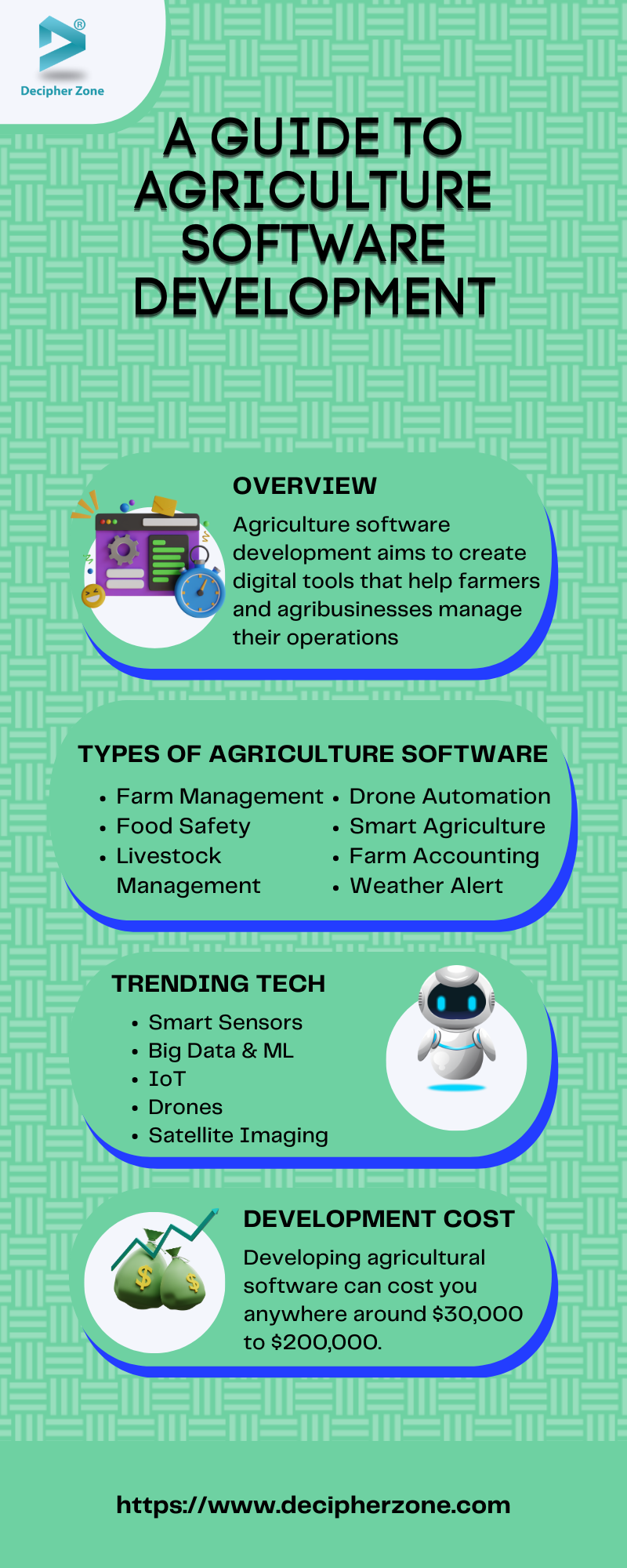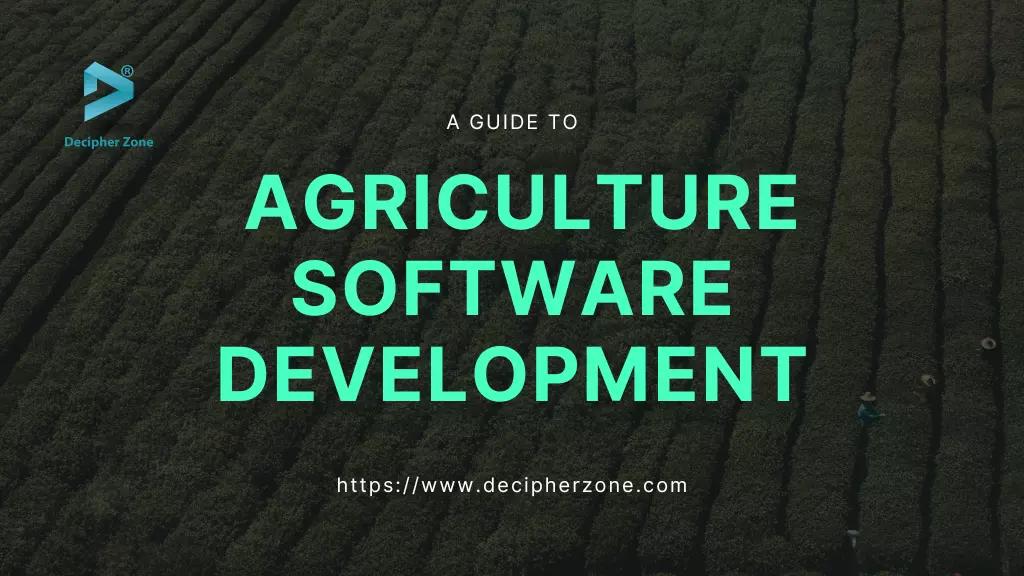How much does it cost to develop an Agricluture Software in 2023? In human history, agriculture has played a significant role in food production. It has been radically altered over the years with advances in machinery, leading to efficient land cultivation.
Now, with the emergence of technologies like Artificial Intelligence, connected sensors, and analytics, it has become possible for farmers to build sustainability, improve water, fertilizers, and other inputs, and crop cultivation resilience with ease.
And agriculture software development serves as a key to leveraging these technologies. So, in this blog, we will cover everything about developing agricultural software to help farmers enhance their processes and productivity.
What is Agriculture Software Development?
Agriculture software development aims to create digital tools that help farmers and agribusinesses manage their operations. They provide valuable insights into farm operations, are user-friendly, and automate tasks.
Read: Software Development Challenges and Solutions
With the combination of computer science and engineering with physical science research and development, agriculture software provides incredible insights and control over operations and lands.
Read: Financial Software Development Cost
Pest and Disease Control, Time Optimization, Livestock Management, Record-Keeping, Land Mapping, Crop Loss Prevention, Risk Management, and Performance Monitoring are some of the essential agricultural processes that are made easier for farmers through the real-time data access available in the agriculture software.
Read: Educational Software Solutions Development
Benefits of Agriculture Software Development in 2023
Some of the benefits that agriculture software offers are:
-
Better management of field operations and workers through clear and timely instructions, work progress monitoring, machine utilization and telematics records, and work performance and productivity analysis.
-
By computing and evaluating rate scripts, return on investment, water usage, and rainfall forecasts, agriculture software can provide insights to improve input efficiency.
-
It also helps in optimizing inventory management and finances to increase profits by analyzing crop variety, field, and profitability as well as monitoring crop inventory to avoid over-purchasing.
-
Secured compliance and traceability, continuously improved practices, and simplified farm administration are a few more benefits that come with using agriculture software.
Types of Agriculture Software Development in 2023
Here is the list of 7 types of Agriculture Software development in 2023.
-
Farm Management
-
Food Safety Compliance:
-
Livestock Management
-
Drone Automation
-
Smart Agriculture
-
Farm Accounting
-
Weather Alert
Agriculture software can be divided into different categories, depending on the use cases.
-
Farm Management: It helps farmers in managing, centralizing, and optimizing their production activities. Using farm management software makes it easier for farmers to take informed strategic decisions to improve task efficiencies.
-
Food Safety Compliance: It is a systematic approach for managing food safety risks in a food business to ensure that the food is safe to ingest. Food safety management software follows CCP identification, hazard analysis, procedure monitoring, and record-keeping with other principles to ensure food safety.
-
Livestock Management: This software requires knowledge of animal husbandry and animal technology as it helps in supervising farm operations and managing cattle. Livestock management software aims to make the care-taking of agricultural-associated livestock more efficient.
-
Drone Automation: A smart agriculture drone automation software allows farmers to automate field monitoring, mapping, and analysis for better field management.
-
Smart Agriculture: Implementing AI, Geographical Information System (GIS), sensors, and mapping, smart agriculture software allows farmers to automate manual agriculture processes, acquire crop production transparency, and improve product origin traceability.
-
Farm Accounting: It is a scalable accounting system that allows farmers to manage inventories and track assets & personal expenses to outline profits and losses and take necessary decisions.
-
Weather Alert: It assists farmers in making informed decisions based on the real-time data collected and analyzed about wind speed, temperature, humidity, rainfall, soil moisture, and so on.

Trending Technologies to Implement in Agriculture Software Development in 2023
Let's take a look at some of the most 7 popular and essential technologies that will make it more useful in 2023
Read: Custom Accounting Software
1. Smart Farming Sensors
It helps monitor even the slightest weather and field condition changes in real-time, allowing farmers to make improvements accordingly.
2. Big Data
With big data analytics, farmers can track fertilizer requirements, rainfall patterns, and water cycles to improve yield management.
3. Machine Learning
ML has the potential to disrupt the agriculture sector as it helps automate iterative processes. Machine learning can assist in accurate yield prediction, pest and disease identification, weed detection, crop and plant identification, crop quality diagnosis, and more.
4. Internet of Things (IoT)
IoT sensors help in collecting machine and environmental metrics for improving water conservation, better production rates, real-time data analytics, predicting crop water requirements, detecting herd health, and minimizing operational costs.
5. Agricultural Drones
Using automated drones in agriculture to monitor livestock, crop conditions, field analysis, and irrigation from the air to optimize field operations and identify potential problems.
6. Satellite Imaging
It is a powerful tool that revolutionizes the management of irrigation. Satellite imaging uses sensors to capture crop health data through updated views of the land and planted crops, including normalized difference vegetation index (NDVI).
This technology is adopted in precision agriculture for its accuracy and cost-effectiveness. Satellite imaging can even help measure details like soil temperature and moisture to improve crop health.
Agriculture Software Development Cost in 2023
Developing an Agriculture Software in 2023 can cost you anywhere around $30,000 to $200,000 depending on the features, integrations, functionalities, technologies, and complexity of the application.
While a basic agriculture software development with minimal features will range somewhere between $30,000 to $55,000, a complex one with advanced features can cost up to $200,000 and more.
Read: Website Development Cost
If you want to know the exact cost of developing an agriculture web application that is ideal for your business needs, then contact our team of experts and hire experienced developers now!
FAQs About Agriculture Software Development
What is agriculture software?
Agriculture software is developed to gain valuable insights into farm operations to help farmers and agribusinesses manage their operations efficiently. Providing clear and timely instructions, monitoring work progress, monitoring machine usage and telematics records, as well as analyzing worker performance and productivity, agriculture software allows for better management of field operations and workers.
What are the technologies used in agriculture?
Smart sensors, Big Data, Machine Learning, IoT, Drones, and Satellite Imaging are some of the technologies popularly used for agriculture management.
Which programming language is used in agriculture software development?
Java, Python, PHP, and JavaScript are a few programming languages that can be used to develop and manage agriculture software applications.

